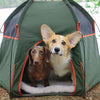Safely Hiking or Backpacking With Your Dog
Posted by Michael Shine
For starters, puppies aren’t ready to carry a load, nor are their immune systems prepared to take on the world. So you need to work out exactly when your dog will be ready. Dog walking a small dog daily is a good idea. If your pup is slow, start with 200 feet or less than gradually increase your distance until you feel your puppy walking you.
Visit the Vet: Ask your veterinarian some critical questions before you and your dog head into the wilds:
Is your dog physically ready?
Does your dog need any specific vaccinations or preventative medicines?
Is your dog’s immune system ready?
Know Your Trail Regulations: Always check on the regulations for the areas where you’ll be hiking or backpacking. Most U.S. national parks, for example, do not allow even dogs on a leash to share the trail. Many national forests in the United States, as well as state and local parks, do allow dogs on their trail systems, though rules vary. Leashes are mandatory almost everywhere, as are poop bags, so you leave no trace. Please follow the dog-friendly regulations for your country.
Food and Water Guidelines to Follow
Being on the trail all day requires you to provide more food and water than your dog typically consumes. All dog walkers should have dog packs that include a pool for any outdoor adventures.
Larger dogs might drink 0.5 to 1.0 ounces of water per pound per day. Dogs 20 pounds and lighter will be closer to 1.5 ounces per pound per day. These are general guidelines, though, so you need to be watchful and offer water often, especially on hot days. If the nose is dry, then you’re under-hydrating your dog.
The rule of thumb for feeding is that you need to start with the usual amount of food, then add one cup for every 20 pounds of dog weight.
Tip: If you’re thirsty, hungry, or tired, then the chances are that your dog is, too. Take a trail break to chow down, drink up, and catch your breath together.
Essential Items for Hiking with Dogs
Leash: Avoid long straps. A better choice is either a short leash or a moderate leash under 10 feet long. Note: Some state parks require dogs to be on a leash that is 10 feet or shorter.
Dog brush and comb: This will help to keep your dog’s fur deburred. On some long-haired breeds, if their coat gets knotted enough, they will refuse to move another inch even if they are 10 miles from the car.
Your pet should have a collar with your phone numbers and your dog’s name, rabies tag, and dog license on it for any emergencies.
Dog booties are almost impossible to get on your pooch but are great to protect sensitive dog paws or if your dog cuts a pad or tears a claw.
Water: Carry at least a quart of water for your dog for every 3 miles you plan to hike if there are no reliable water sources along the route check your hiking guide and plan accordingly.
Dog food/snacks: Bring actual dog food and dog biscuits, which are nutritionally balanced (fewer carbs and more fat, protein) and more manageable for dogs to digest than human food.
Spare rope: Depending on what you carry for a leash, an extra line is helpful for times when you need to tie your dog to a tree or another fixed object.
Poop bags: if your dog does its business anywhere above treeline, along with a trail, or in a camping area, and you need to pack it out.
Dog first-aid kit: Basic components should include the following:
- Bandage scissors
- Dog toenail clippers
- Tweezers
- Cleansers and disinfectants such as hydrogen peroxide and Betadine
- Canine eyewash
- Calamine lotion (for itchy bug bites)
- Topical antibiotic ointments such as Bacitracin or Neomycin
- Baking soda (for bee stings)
- Vaseline
- Stop bleeding powder
- Enteric-coated aspirin or Bufferin
- Imodium A-D
- Pepto-Bismol
- Dressings and bandages
- Gauze pads (4 inches square)
- Gauze roll
- Non-stick pads
- Adhesive tape (1- and 2-inch rolls) Duct Tape
These simple beginners guide can take your knowledge level from total newbie to at least beginner, if not intermediate. Knowing these things will also help make the hike more enjoyable and safer for both you and your dog.
 5 Star Customer Reviews
5 Star Customer Reviews FREE Shipping Over $39
FREE Shipping Over $39
 Exceptional Customer Care
Exceptional Customer Care





